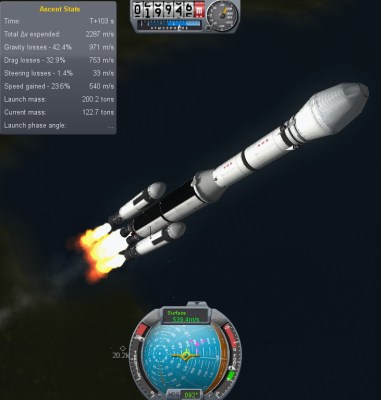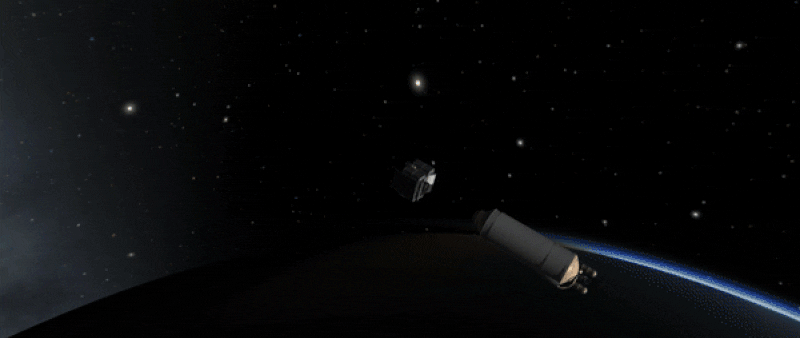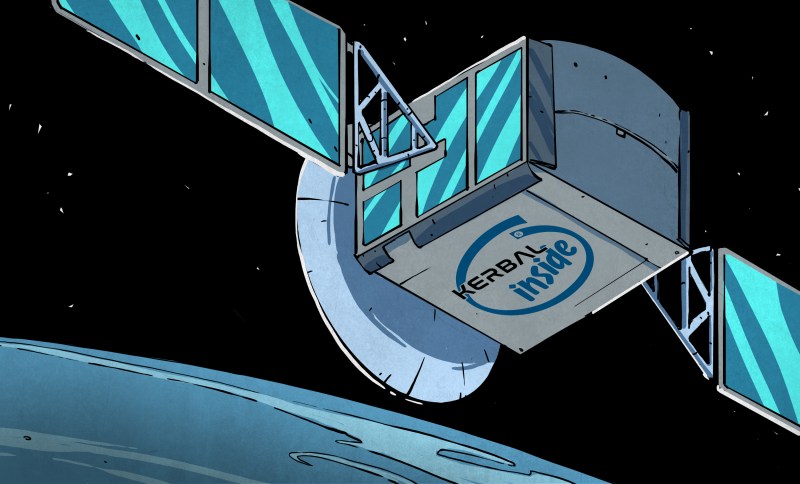Just a few weeks before Atlantis embarked on the final flight of the Space Shuttle program in 2011, a small Mexican company by the name of Squad quietly released Kerbal Space Program (KSP) onto an unsuspecting world. Until that point the company had only developed websites and multi-media installations. Kerbal wasn’t even an official company initiative, it started as a side project by one of their employees, Felipe Falanghe. The sandbox game allowed players to cobble together rockets from an inventory of modular components and attempt to put them into orbit around the planet Kerbin. It was immediately addictive.
There was no story to follow, or enemies to battle. The closest thing to a score counter was the altimeter that showed how far your craft was above the planet’s surface, and the only way to “win” was to put its little green occupant, the titular Kerbal, back on the ground in one piece. The game’s challenge came not from puzzles or scripted events, but from the game’s accurate (if slightly simplified) application of orbital mechanics and Newtonian dynamics. Building a rocket and getting it into orbit in KSP isn’t difficult because the developers baked some arbitrary limitations into their virtual world; the game is hard for the same reasons putting a rocket into orbit around the Earth is hard.

Over the years official updates added new components for players to build with and planets to explore, and an incredible array of community developed add-ons and modifications expanded the scope of the game even further. KSP would go on to be played by millions, and seeing a valuable opportunity to connect with future engineers, both NASA and the ESA helped develop expansions for the game that allowed players to recreate their real-world vehicles and missions.
But now after a decade of continuous development, with ports to multiple operating systems and game consoles, Squad is bringing this chapter of the KSP adventure to a close. To celebrate the game’s 10th anniversary on June 24th, they released “On Final Approach”, the game’s last official update. Attention will now be focused on the game’s ambitious sequel, which will expand the basic formula with the addition of interstellar travel and planetary colonies, currently slated for release in 2022.
Of course, this isn’t the end. Millions of “classic” KSP players will still be slinging their Kerbals into Hohmann transfer orbits for years to come, and the talented community of mod developers will undoubtedly help keep the game fresh with unofficial updates. But the end of official support is a major turning point, and it seems a perfect time to reminisce on the impact this revolutionary game has had on the engineering and space communities.
Flights of Fancy
By the numbers, there’s no question that DOOM is the game which has most frequently graced the pages of Hackaday. After all, porting the 1993 shooter to a new or unusual piece of hardware is a rite of passage for hackers. Minecraft also pops up plenty of times, though in many cases, it’s more about some new in-game feat of engineering than anything corporeal.
But as for which single game has inspired the most peripherals, Kerbal Space Program surely takes the top spot. The first KSP controller we covered was back in 2015, and it combined a joystick, lighted push buttons, aircraft style toggles, and a trio of screens to read out various bits of in-game data. To somebody who’s never piloted a craft in KSP it might seem like overkill, but each and every one of those buttons and displays would be playing an important role as your meticulously designed lander descended to the surface of the Mun, KSP’s stand-in for Earth’s nearest celestial neighbor.
Speaking of the Mun, the first appearance of KSP on Hackaday was when alum Brian Benchoff launched a mission to map Kerbin’s rocky natural satellite in 2012. Notably his attempt took place long before the game officially added in the sort of instrumentation that was necessary to observe a celestial body from orbit, so he used community developed add-ons to build his mapping satellite. After days of scanning the Mun from a polar orbit, he had collected enough data to recreate his own three dimensional model of the in-game world that was suitable for 3D printing.
Bringing Space Down to Earth
The array of projects we’ve seen focused on KSP is certainly impressive, but the people creating custom cockpits for their virtual spacecraft are just one tiny segment of the larger community. What the game will truly be remembered for is how it took a complex subject like orbital mechanics and brought it to millions of people in an approachable and fun way. You can read all about how the Apollo spacecraft performed the trans-lunar injection (TLI) maneuver, but if you really want to wrap your head around it, just start up KSP and do it for yourself.
KSP made space exploration relatable in a way which wasn’t possible before. Earlier spaceflight simulators such as Orbiter — as impressive as they were — were a bit too grounded in reality to capture the public’s imagination. The key to what made KSP so successful was how expertly the developers balanced realism and fun. NASA could challenge the public to recreate their own real-world missions in Kerbal’s solar system knowing that the game had all the principle parts necessary to fashion a serviceable analog, but without the pedantry that would make it impossible for the armchair astronaut to complete. KSP didn’t just reaffirm what everyone already knew, that spaceflight is monstrously complex, it served as a way to teach the average person why it’s so difficult.

Whether there’s a preteen or an retiree at the controls, there’s something new to discover by playing KSP. But more than that, the game can be used as a powerful learning tool even if the audience is just passively watching. Scott Manley started out by simply recording himself building rockets in KSP, and parlayed that into Internet fame as a science educator with more than 1.2 million subscribers on YouTube. He was recently tapped as an expert spaceflight consultant for the Netflix film Stowaway, where he used KSP to show the director what a practical Mars spacecraft might look like.
Felipe Falanghe’s plucky rocket simulator, inspired by his childhood experiments with fireworks, will be forever remembered as one of the most successful indie games of all time. But that won’t be its most lasting impression on the world. While an astronaut aboard the Space Shuttle in the 1990s might have credited Star Trek for igniting their interest in space, there’s an excellent chance that the first person to step foot on Mars will have clocked in plenty of hours in Kerbal Space Program.





















They may have stopped work on the original, but they’re carrying it forward next year with a new cut.
At least all the mods will be updated to newest KSP version…
Probably using a different game engine to have it work on multiplayer. In any case, one should never base actual gameplay on cutscenes or trailers (they mentioned in the trailer that it’s not actual gameplay so there’s that). The things breaking in the trailer is only obviously to dramatize, not sure why anyone would assume that KSP2 would have realistic debris from crashes.
Just play games as it is, it would save you from a lot of headache and disappointment from trying to incorporate the hype-materials with the actual game.
There have been many other games where fast-forwarding or fast travelling have been implemented in multiplayer. It’s as simple as scheduling a time travel (where it can prompt every player in the server that speed up time is requested). There’s a lot of ways where this can be implemented properly, so I hope you’re not tunnel-visioned into thinking that KSP will forever be a broken game. Support the game, and if you don’t like it, then by all means stop playing it.
Also… Cutscenes are cut scenes. It does not depict actual game play (and it even says so in the actual KSP2 cutscene that it’s not the actual gameplay).
You could maybe do it in realtime with machine learning. They’ve now done fluid simulations by training on the Navier Stokes equations, and apparently the techniques also apply to nearly any set of partial differential equations.
“The game’s challenge came not from puzzles or scripted events, but from the game’s accurate (if slightly simplified) application of orbital mechanics and Newtonian dynamics.”
I seem to remember asking, but there are certain orbits it can’t do.
” But that won’t be its most lasting impression on the world. ”
The explosion of realistic simulator games in the marketplace.
There is a mod that simulates n-body gravitational bodies, https://github.com/mockingbirdnest/Principia
Probably the biggest limitation is that there are no Lagrange points, due to the simplified simulation of objects you aren’t currently in orbit around. So you can’t simulate the orbit that the James Webb Space Telescope is going into, for example.
There are mods to implement more robust orbital physics though, as well as ones to replace the Kerbal solar system with a recreation of our own. So if you want the game to be more accurate, the options are there.
I don’t think this game’s success has anything to do with its physics, but rather with its arcade features. Orbiter has been around since at least 2006 and out has always been a more realistic simulator, any way you look at it. In fact, Orbiter is the only sim where you can recreate every single Space Shuttle mission, as well as the Moon Landing (using real Apollo code). And for some reason it’s nowhere near as popular.
Fact is people like funny looking humanoid characters more than realism. Nothing wrong with that, it’s just something to think about.
Did you actually read the post? That’s literally what it said. Even mentions Orbiter by name.
orbiter was a simulator hands down. ksp is a game which happens to have simulator features. while you could nerd away on orbiter for hours, kerbal was actually fun and accessible to a wider audience. you could be reading the orbiter user manuals (they were all in pdf format and quite long) or you could be building (and exploding) rockets and watching your little green men flail around in terror (except for jeb which seems to be happiest when things are going wrong). filipe was a big fan of orbiter, but he knew it wasnt fun for the masses. the real miracle of ksp was that he managed to make it fun to play without sacrificing too much realism in the process.
I think the part of the difference is that KSP is much more accessible than Orbiter.
If I wanted to fly a full Shuttle mission in Orbiter, I’d basically have to learn how to fly an actual Shuttle. If I then decided to fly the LEM, I’d have to learn an entirely new vehicle, with a completely different control panel and gaages, and that’s before having to grapple with flying a completely different machine in a completely different environment.
Not only does KSP simplify things by having a consistent UI and controls for everything, but you can learn at your own pace, eg learn to get into space in a simple capsule first, and then progress up to space-planes or lunar (munar) landers.
It’s also part of the fun. I can build a Shuttle replica (although it’s pretty tricky to build something that flies nicely), but if I decide to, I can alter my design and build something to travel to a different planet and try flying there. Or I can build a lunar lander, work out how to get it there, crash on landing, and have to go back to the drawing board to design a rescue mission.
Orbiter can let me fly a Shuttle, but KSP lets me design, build, and fly a Shuttle, and learn about rocketry and physics at the same time.
I used to bring my (thick!) Orbiter 2006 flight manual with me on the bus to university. I had an engineering degree and most of a PhD at that point, but it was still heavy going. That made it feel like an accomplishment when I got the shuttle to orbit for the first time. KSP let me go and try a bunch of stuff and not feel too bad about it exploding horribly (well, not -too- bad, at least). They both had their uses.
Orbiter was first released in 2000, with the latest version being out in 2016.
Is this still actual?
Kerbal Space Program: Spyware Level: EXTREMELY HIGH
https://spyware.neocities.org/articles/ksp.html
idk, they did add telemetry to the game at one point, though its possible to opt out of this on your first run. like its the only piece of software on your computer with telemetry baked in. at least it gives you an option to disable it and its not hidden.
It was hidden at first.
I’m not sure if it is still baked in, but they used “telemetry” software made by a 3rd party that scooped up uncomfortable amounts of data. It was a big scandal once people found out about all the games that included this package. Kerbal got caught up in it. I haven’t played it since, but I don’t know if that’s still the case. If they removed it, I might get those updates and play again.
Judging by the fact that some of the “sources” this Neocities page (WTF?) seem to conclude that the claims are false or exaggerated, I’d say no.
I mean…how would KSP even get your age or mailing address? What’s next, can’t launch the rocket unless you type in mother’s maiden name?
This should be mandatory if you’re initiating the self-destruct sequence!
this is going to be a boon to the modding scene. the advantages of having the game in a finalized state will be huge. modding a game that is still in active development sucks. its not like the quake modding days where the game was pretty much in its final state from the start. with kerbal, every new version moves the goal posts and at minimum needs a recompile of your mod source, and at most a major overhaul. now that kerbal is finalized, it means that modders will be able to work without needing to worry about moving targets. all new mods will target the most recent version and old mods can be recompiled and finalized one final time (this is where their policy that all mods be published with source will really pay off). needing to have 4 different versions of the game installed to run certain mod stacks might no longer be a thing, except for cases of extreme nostalgia. right now is possibly the best time to go kerbal.
Postal 2 supporrt was also meant to end with release of Apocalypse Weekend, yet here we are in 2021, still using Dude’s firehose to cool down pedestrians in a sunny town called Paradise.
I might be tempted to dig out the old parts pack mod I took over and added a bunch of stuff to. It was called “ReStock” and how it worked was simply modifications of stock .cfg files for parts to re-size and/or combine 2 or more parts into one.
I kept it updated through 3 or 4 releases but gave up because with every new release SQUAD would relocate most of the parts to new directory paths so I’d have to edit every last modified .cfg file to fix them. It wasn’t just file locations they’d change. For one version they altered parameters for attachment node positions so I had to have the current and previous versions of KSP and tweak positions in order to get things back where they should be. Then the next version those changes got reverted so I had to move the node positions back where they’d been.
I didn’t do much with the spaceplane parts. Some I took out (like the “Space Pants” 1 large to 2 small adapter) that KSP came to have official versions doing the same job, rather than the munged together pieces in this pack. Not saying they were inspired by this pack, weren’t my creations anyway.
If someone wants to take the mod over I have three versions of the pack here, plus a cubical strut piece someone made per my request. It matches the larger rectangular strut/girder parts and other pieces with the same size square attachments. No idea why such a useful part has never been an official KSP part. However, there’s *something* funky with it where it doesn’t always want to connect with some of the nodes unless it’s rotated around some. No idea why and the guy who made it just did it quick and basically said it works well enough.
http://www.partsbyemc.com/pub/
You can see some of the ReStock parts (Especially my Thunder Maximus mega sized parts) in my 2014 mission to Eve and back. https://imgur.com/gallery/2C8Iw
I remember buying KSP for $10 in possibly still Alpha times.
The best thing they did was hire some of their most prolific modders as staff. They encouraged and embraced their mod community, while so many big companies make it a fight for modders.
The best thing about the internet is how people around the world can work on a project they are doing because it’s what they want, and no-one else is doing to their liking. A guy that wanted to make a fun, but realistic rocket game got out there and did it because no-one else was, and with the internet, turned it into a career and made a living off what started as a hobby.